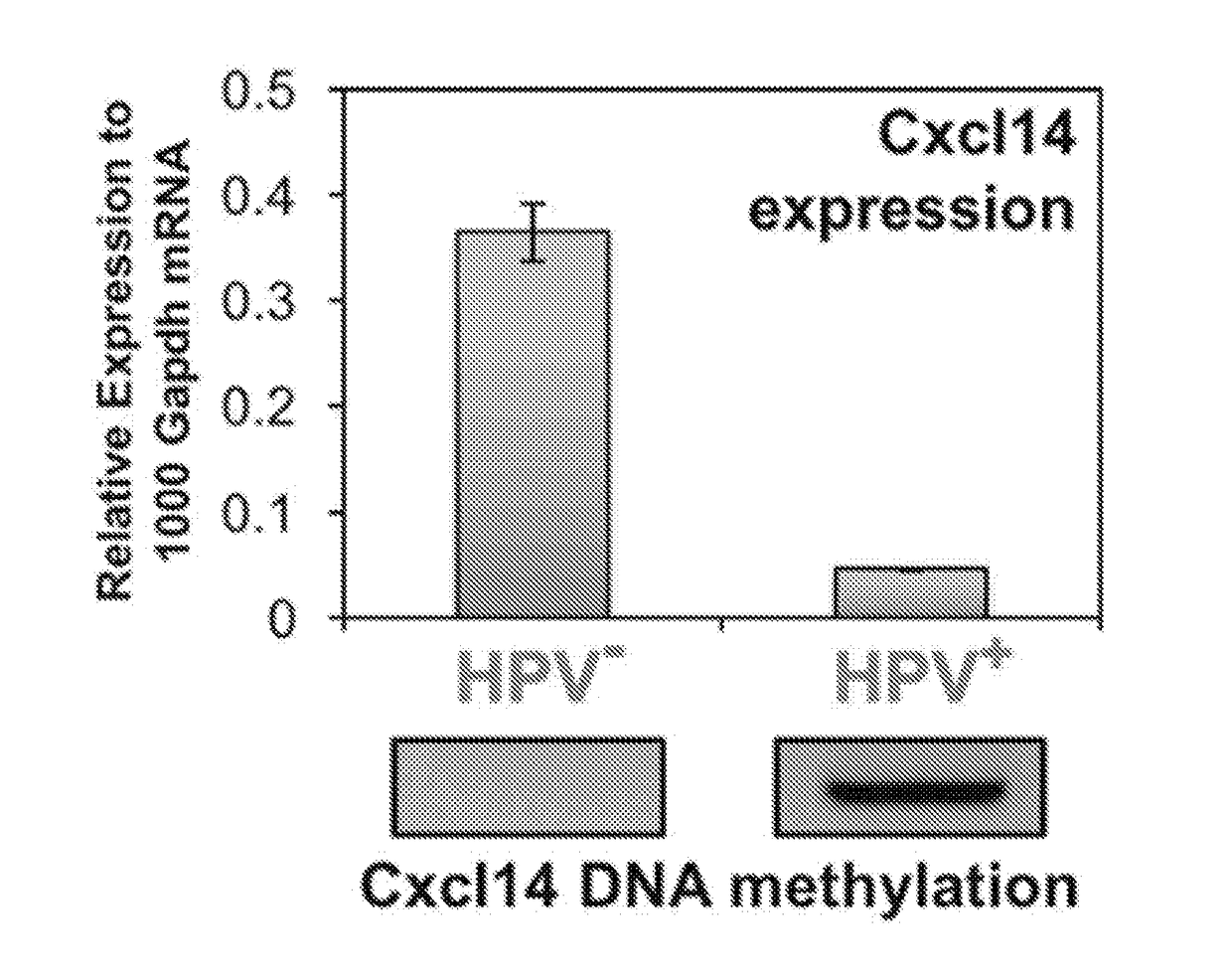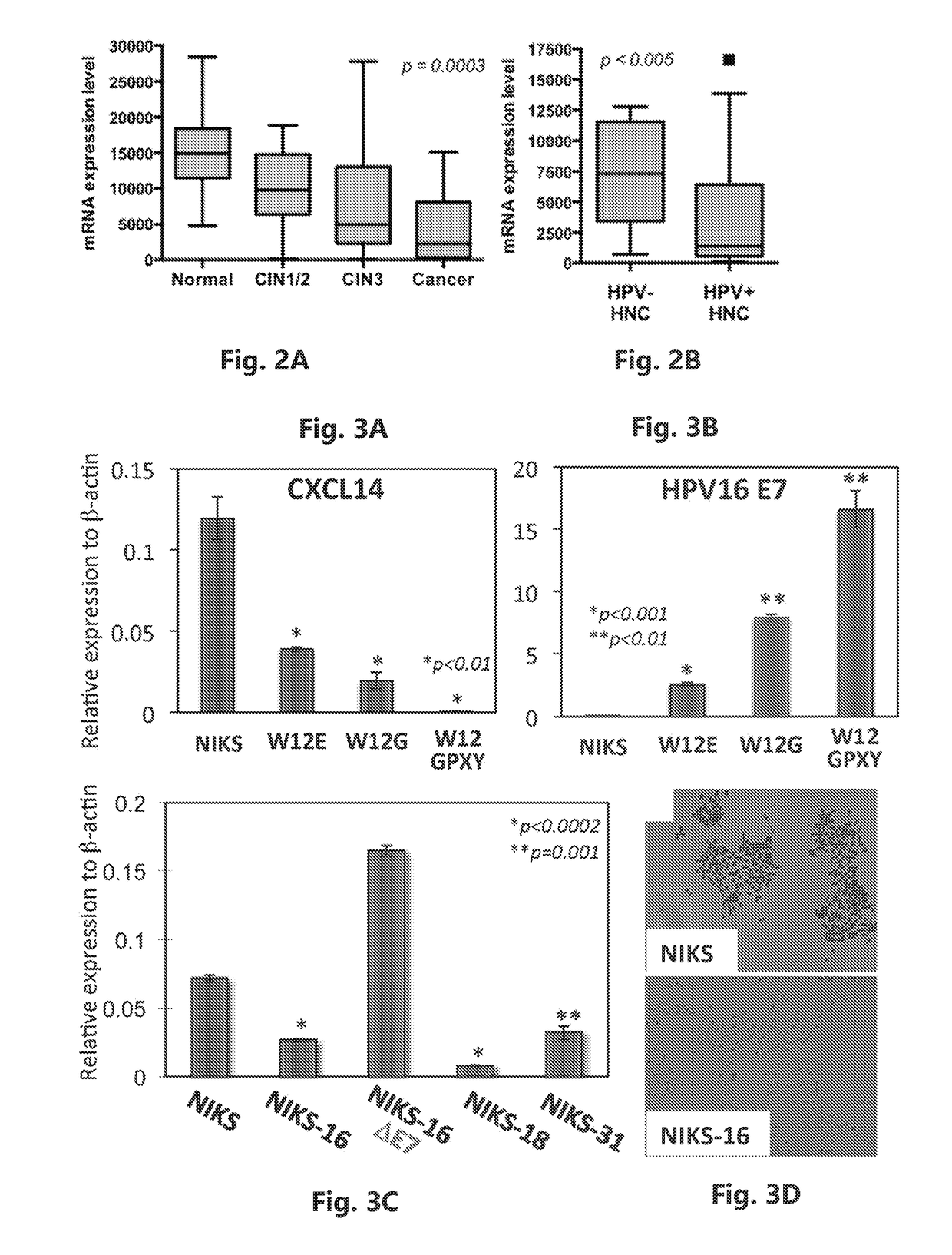Prognosis and treatment of squamous cell carcinomas
a squamous cell carcinoma and prognosis technology, applied in the field of dna methylation as a predictor of patient prognosis, can solve the problems of little knowledge about the molecular mechanisms of hnscc disease progression driven by hpv, poor survival rate of hpv+ hnsccs with nodal metastasis, etc., to achieve the effect of increasing cd8+ t and natural killer cell populations
- Summary
- Abstract
- Description
- Claims
- Application Information
AI Technical Summary
Benefits of technology
Problems solved by technology
Method used
Image
Examples
example 1
Global Gene Expression Profiles of 84 Fresh Frozen, Human Cervical and Head / Neck Tissue Specimens, Comparing HPV+ and HPV− Cancers
[0086]Previous results revealed striking HPV-specific gene expression signatures that allowed for distinction of HPV+ HNSCCs and cervical cancers (CxCa) from HPV− HNSCCs. These findings clearly indicate that HPV plays a pivotal role in HPV-associated cancer development. The inventors further analyzed global gene expression profiles of 128 cervical tissue specimens in different disease stages including normal, early and late premalignant epithelial lesions, and squamous cancers. The results revealed a cascade of molecular changes culminating in numerous gene expression changes at the final transition to invasive epithelial cancer. To understand immune modulation by HPV in the local microenvironment during HPV-associated cancer progression, the inventors analyzed all chemokine expression alterations using the gene expression data sets from 218 human head / ne...
example 2
omoter Hypermethylation in HPV+ Cells
[0088]Previous studies have shown that CXCL14 expression can be suppressed by promoter hypermethylation. To determine whether decreased CXCL14 expression is linked to promoter hypermethylation, the inventors performed methylation-specific PCR (MSP) using NIKS and W12 cell lines. CXCL14 promoter methylation is inversely correlated with CXCL14 expression, and there is significantly increased CXCL14 promoter hypermethylation in HPV+ keratinocytes and HNSCC cells (FIG. 4). CXCL14 promoter hypermethylation disappears in NIKS-16ΔE7 cells. These results suggest that CXCL14 promoter hypermethylation is induced by high-risk HPVs and accumulated throughout cancer progression. A previous study showed that the HPV oncoprotein E7 activates the methyltransferase activity of DNMT1. Additionally, epigenetic silencing of many genes has been shown in HPV+ cells and in CxCa. The inventors' data also showed that DNMT1 expression is increased specifically in HPV+ HNS...
example 3
-Expression in HNSCC Cells Clears Tumors Through Adaptive Immunity
[0089]CXCL14 is an evolutionary-conserved chemokine showing 98% homology between human CXCL14 and murine Cxcl14. To determine whether CXCL14 affects tumor growth in vivo, the inventors studied mouse oropharyngeal epithelial cells (MOE / E6E7) that form tumors in immunocompetent syngeneic C57BL / 6 (B6) mice. Consistent with the human cell lines and patient tissues, MOE / E6E7 cells were found to express significantly less Cxcl14 than the syngeneic HPV− MOE cells and were shown to have a highly methylated Cxcl14 promoter (FIG. 7). To test tumor suppressor functions of CXCL14, the inventors established MOE / E6E7 cell lines that re-expressed their physiological levels of Cxcl14. Strikingly, a majority of B6 mice injected with MOE / E6E7 cells expressing Cxcl14 cleared tumors, while all mice injected with control MOE / E6E7 cells succumbed to tumor burdens within 21 days (FIG. 8A). However, contrary to wildtype B6 mice, all Rag1-def...
PUM
| Property | Measurement | Unit |
|---|---|---|
| size | aaaaa | aaaaa |
| fluorescence intensities | aaaaa | aaaaa |
| volume | aaaaa | aaaaa |
Abstract
Description
Claims
Application Information
 Login to View More
Login to View More - R&D
- Intellectual Property
- Life Sciences
- Materials
- Tech Scout
- Unparalleled Data Quality
- Higher Quality Content
- 60% Fewer Hallucinations
Browse by: Latest US Patents, China's latest patents, Technical Efficacy Thesaurus, Application Domain, Technology Topic, Popular Technical Reports.
© 2025 PatSnap. All rights reserved.Legal|Privacy policy|Modern Slavery Act Transparency Statement|Sitemap|About US| Contact US: help@patsnap.com



